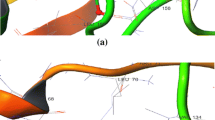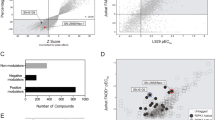Abstract
Necroptosis, a programmed necrosis pathway, is witnessed in diverse human diseases and is primarily regulated by receptor-interacting serine/threonine protein kinase 1 (RIPK1) and RIPK3. Ablation or inhibition of these individual proteins, or both, has been shown to be protective in various in vitro and in vivo disease models involving necroptosis. In this study, we propose an effective and rapid virtual screening strategy to identify multitarget inhibitors of both RIPK1 and RIPK3. It involves ensemble pharmacophore-based screening (EPS) of a compound database, post-EPS filtration (PEPSF) of the ligand hits, and multiple dockings. Structurally diverse inhibitors were identified through ensemble pharmacophore features, and the speed of this process was enhanced by filtering out the compounds containing cross-features. The stability of these inhibitors with both of the proteins was verified by means of molecular dynamics (MD) simulation.

A generalized workflow employed in this study. Subsequent utilization of EPS and PEPSF might lead to reduced computational time and load.













Similar content being viewed by others
References
Thornton C, Rousset CI, Kichev A, Miyakuni Y, Vontell R, Baburamani AA, Fleiss B, Gressens P, Hagberg H (2012) Molecular mechanisms of neonatal brain injury. Neurol Res Int 506320:1–16. doi:10.1155/2012/506320
Zhang DW, Shao J, Lin J, Zhang N, Lu BJ, Lin SC, Dong MQ, Han J (2009) RIP3, an energy metabolism regulator that switches TNF-induced cell death from apoptosis to necrosis. Science 325:332–336. doi:10.1126/science.1172308
He S, Wang L, Miao L, Wang T, Du F, Zhao L, Wang X (2009) Receptor interacting protein kinase-3 determines cellular necrotic response to TNF-alpha. Cell 137:1100–1111. doi:10.1016/j.cell.2009.05.021
Fayaz SM, Suvanish Kumar V, Rajanikant GK (2014) Necroptosis: who knew there were so many interesting ways to die? CNS Neurol Disord Drug Targets 13:42–51. doi:10.2174/18715273113126660189
Linkermann A, Hackl MJ, Kunzendorf U, Walczak H, Krautwald S, Jevnikar AM (2013) Necroptosis in immunity and ischemia reperfusion injury. Am J Transplant 13:2797–2804. doi:10.1111/ajt.12448
Mehta SL, Manhas N, Raghubir R (2007) Molecular targets in cerebral ischemia for developing novel therapeutics. Brain Res Rev 54:34–66. doi:10.1016/j.brainresrev.2006.11.003
Meylan E, Burns K, Hofmann K, Blancheteau V, Martinon F, Kelliher M, Tschopp J (2004) RIP1 is an essential mediator of Toll-like receptor3-induced NF-kB activation. Nat Immunol 5:503–507. doi:10.1038/ni1061
Linkermann A, Green DR (2014) Necroptosis. N Engl J Med 370:455–465. doi:10.1056/NEJMra1310050
Vandenabeele P, Galluzzi L, Vanden Berghe T, Kroemer G (2010) Molecular mechanisms of necroptosis: an ordered cellular explosion. Nat Rev Mol Cell Biol 11:700–714. doi:10.1038/nrm2970
Chan FK, Shisler J, Bixby JG, Felices M, Zheng L, Appel M, Orenstein J, Moss B, Lenardo MJ (2003) A role for tumor necrosis factor receptor-2 and receptor-interacting protein in programmed necrosis and antiviral responses. J Biol Chem 278:51613–51621. doi:10.1074/jbc.M305633200
Holler N, Zaru R, Micheau O, Thome M, Attinger A, Valitutti S, Bodmer JL, Schneider P, Seed B, Tschopp J (2000) Fas triggers an alternative, caspase-8-independent cell death pathway using the kinase RIP as effector molecule. Nat Immunol 1:489–495. doi:10.1038/82732
Lin Y, Choksi S, Shen HM, Yang QF, Hur GM, Kim YS, Tran JH, Nedospasov SA, Liu ZG (2004) Tumor necrosis factor induced non-apoptotic cell death requires receptor-interacting protein-mediated cellular reactive oxygen species accumulation. J Biol Chem 279:10822–10828. doi:10.1074/jbc.M313141200
Ch’en IL, Tsau JS, Molkentin JD, Komatsu M, Hedrick SM (2011) Mechanisms of necroptosis in T cells. J Exp Med 208:633–641. doi:10.1084/jem.20110251
Degterev A, Huang Z, Boyce M, Li Y, Jagtap P, Mizushima N, Cuny GD, Mitchison TJ, Moskowitz MA, Yuan J (2005) Chemical inhibitor of nonapoptotic cell death with therapeutic potential for ischemic brain injury. Nat Chem Biol 1:112–119. doi:10.1038/nchembio711
Smith CC, Davidson SM, Lim SY, Simpkin JC, Hothersall JS, Yellon DM (2007) Necrostatin: a potentially novel cardioprotective agent? Cardiovasc Drugs Ther 21:227–233. doi:10.1007/s10557-007-6035-1
Xu X, Chua CC, Kong J, Kostrzewa RM, Kumaraguru U, Hamdy RC, Chua BH (2007) Necrostatin-1 protects against glutamate induced glutathione depletion and caspase-independent cell death in HT-22 cells. J Neurochem 103:2004–2014. doi:10.1111/j.1471-4159.2007.04884.x
Bao L, Li Y, Deng SX, Landry D, Tabas I (2006) Sitosterol containing lipoproteins trigger free sterol-induced caspase-independent death in ACAT-competent macrophages. J Biol Chem 281:33635–33649. doi:10.1074/jbc.M606339200
Hong Q, Hsu LJ, Schultz L, Pratt N, Mattison J, Chang NS (2007) Zfra affects TNF-mediated cell death by interacting with death domain protein TRADD and negatively regulates the activation of NF-kappaB, JNK1, p53 and WOX1 during stress response. BMC Mol Biol 8:50. doi:10.1186/1471-2199-8-50
Degterev A, Hitomi J, Germscheid M, Ch’en IL, Korkina O, Teng X, Abbott D, Cuny GD, Yuan C, Wagner G, Hedrick SM, Gerber SA, Lugovskoy A, Yuan J (2008) Identification of RIP1 kinase as a specific cellular target of necrostatins. Nat Chem Biol 5:313–321. doi:10.1038/nchembio.83
Ch’en IL, Beisner DR, Degterev A, Lynch C, Yuan J, Hoffmann A, Hedrick SM (2008) Antigen-mediated T cell expansion regulated by parallel pathways of death. Proc Natl Acad Sci USA 105:17463–17468. doi:10.1073/pnas.0808043105
Ting AT, Pimentel-Muinos FX, Seed B (1996) RIP mediates tumor necrosis factor receptor 1 activation of NF-kappaB but not Fas/APO-1-initiated apoptosis. EMBO J 15:6189–6196
Kaiser WJ, Upton JW, Long AB, Livingston-Rosanoff D, Daley-Bauer LP, Hakem R, Caspary T, Mocarski ES (2011) RIP3 mediates the embryonic lethality of caspase-8-deficient mice. Nature 471:368–372. doi:10.1038/nature09857
Oberst A, Dillon CP, Weinlich R, McCormick LL, Fitzgerald P, Pop C, Hakem R, Salvesen GS, Green DR (2011) Catalytic activity of the caspase-8-FLIP(L) complex inhibits RIPK3-dependent necrosis. Nature 471:363–367. doi:10.1038/nature09852
Vanlangenakker N, Bertrand MJ, Bogaert P, Vandenabeele P, VandenBerghe T (2011) TNF induced necroptosis in L929 cells is tightly regulated by multiple TNFR1 complex I and II members. Cell Death Dis 2:e230. doi:10.1038/cddis.2011.111
Zou J, Xie HZ, Yang SY, Chen JJ, Ren JX, Wei YQ (2008) Towards more accurate pharmacophore modeling: multicomplex based comprehensive pharmacophore map and most-frequent feature pharmacophore model of CDK2. J Mol Graph Model 27:430–438. doi:10.1016/j.jmgm.2008.07.004
Fayaz SM, Rajanikant GK (2014) Ensemble pharmacophore meets ensemble docking: a novel screening strategy for the identification of RIPK1 inhibitors. J Comput Aided Mol Des 28:779–794. doi:10.1007/s10822-014-9771-x
Nair SB, Fayaz SM, Rajanikant GK (2013) A novel multi-target drug screening strategy directed against key proteins of DAPk family. Comb Chem High Throughput Screen 16:449–457. doi:10.2174/1386207311316060005
Darden T, York D, Pedersen L (1993) Particle mesh Ewald—an N.log(N) method for Ewald sums in large systems. J Chem Phys 98:10089–10093. doi:10.1063/1.464397
Friesner RA, Banks JL, Murphy RB, Halgren TA, Klicic JJ, Mainz DT, Repasky MP, Knoll EH, Shelley M, Perry JK, Shaw DE, Francis P, Shenkin PS (2004) Glide: a new approach for rapid, accurate docking and scoring. 1. Method and assessment of docking accuracy. J Med Chem 47:1739–1749. doi:10.1021/jm0306430
Salam NK, Nuti R, Sherman W (2009) Novel method for generating structure-based pharmacophores using energetic analysis. J Chem Inf Model 49:2356–2368. doi:10.1021/ci900212v
Irwin JJ, Shoichet BK (2005) ZINC—a free database of commercially available compounds for virtual screening. J Chem Inf Model 45:177–182. doi:10.1021/ci049714+
Bender A, Glen RC (2005) A discussion of measures of enrichment in virtual screening: comparing the information content of descriptors with increasing levels of sophistication. J Chem Inf Model 45:1369–1375. doi:10.1021/ci0500177
Jain AN, Nicholls A (2008) Recommendations for evaluation of computational methods. J Comput Aided Mol Des 22:133–139. doi:10.1007/s10822-008-9196-5
Hamza A, Wei NN, Zhan CG (2012) Ligand-based virtual screening approach using a new scoring function. J Chem Inf Model 52:963–974. doi:10.1021/ci200617d
van Aalten DM, Bywater R, Findlay JB, Hendlich M, Hooft RW, Vriend G (1996) PRODRG, a program for generating molecular topologies and unique molecular descriptors from coordinates of small molecules. J Comput Aided Mol Des 10:255–262. doi:10.1007/BF00355047
Humphrey W, Dalke A, Schulten K (1996) VMD: visual molecular dynamics. J Mol Graph 14:33–38. doi:10.1016/0263-7855(96)00018-5
Author information
Authors and Affiliations
Corresponding author
Ethics declarations
Conflict of interest
The authors declare that they have no conflict of interest.
Funding
This study was funded by the Department of Biotechnology, Government of India via the Bioinformatics Infrastructure Facility for Biology Teaching through Bioinformatics (BIF-BTBI) (grant number: BT/BI/25/001/2006, dated 25/03/2011).
Rights and permissions
About this article
Cite this article
Fayaz, S.M., Rajanikant, G.K. Ensembling and filtering: an effective and rapid in silico multitarget drug-design strategy to identify RIPK1 and RIPK3 inhibitors. J Mol Model 21, 314 (2015). https://doi.org/10.1007/s00894-015-2855-2
Received:
Accepted:
Published:
DOI: https://doi.org/10.1007/s00894-015-2855-2




